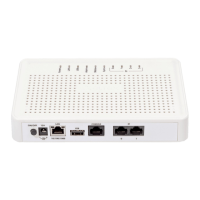SMG digital gateway 77
communication (switching to modem codec will not be initiated, but this operation still may be
performed by the opposite gateway).
VCodec for VBD—the codec which is used for data transmission in the VBD mode.
Payload type for VBD—the load type which is used for data transmission in the VBD mode.
– Static—uses the standard value of the load type for a codec (8 for G.711A codec, 0 for
G.711U codec).
– 96–127—load types from the dynamic range.
Fax settings
Fax detector mode—detects the transmission direction for fax tone detection with subsequent
switching to a fax codec:
– no detect fax—disables fax tone detection, but does not affect fax transmission (switching
to fax codec will not be initiated, but this operation still may be performed by the opposite
gateway);
– Caller and Callee—tones are detected during both fax transmission and reception. During
fax transmission, a CNG FAX signal is detected from the subscriber's line. During fax
reception, a V.21 signal is detected from the subscriber's line;
– Caller—tones are detected only during fax transmission. During fax transmission, a CNG
FAX signal is detected from the subscriber's line;
– Callee—tones are detected only during fax reception. During fax reception, a V.21 signal is
detected from the subscriber's line.
Fax relay mode—the protocol selected for fax transmission.
Fax relay max rate (bps)—the maximum transfer rate of a fax transmitted via the Т.38 protocol.
This setting have influence on the gateway's ability to work with high-speed fax units. If fax units
support data transfer at 14,400 bauds and the gateway is configured to 9,600 bauds, the
maximum rate of connection between the fax units and the gateway will be limited by
9,600 bauds. And vice versa, if fax units support data transfer at 9,600 bauds and the gateway is
configured to 14,400 bauds, this setting does not affect the interaction and the maximum rate is
defined by the fax units.
Fax relay rate management —defines the method of data transfer rate management:
– local TCF—the method requires the TCF tuning signal to be locally generated by the
recipient gateway. It is generally used for T.38 transmission via TCP;
– transferred TCF—the method requires the TCF tuning signal to be sent from the sender
device to the recipient one. It is generally used for T.38 transmission via UDP.
Т.38 data fill bits removal—padding bit removals and inserts for the data which is not related to
ЕСМ (error correction mode).
Т.38 data redundancy—redundancy amount in Т.38 data packets (the number of previous packets
in the next Т.38 packet). Introduction of redundancy allows the transmitted data sequence to be
restored upon reception if some packets have been lost during transmission.
Т.38 data packetization—defines the frequency of Т.38 packets generation in milliseconds (ms).
This option allows size adjustment for a transmitted packet. If the communicating gateway is able
to receive datagrams with max. size of 72 bytes (maxdatagrammSize: 72), the packetisation time
should be set to a minimum in SMG.
Т.38 data transit—when a call is performed using two SIP interfaces with the T.38 fax transfer
protocol being used by both of them, this setting allows the T.38 packets to transit between the
interfaces with a minimum delay.

